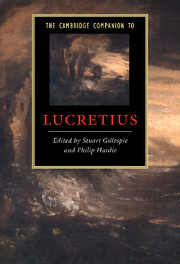Book contents
- Frontmatter
- Introduction
- Part I: Antiquity
- Part II: Themes
- Part III: Reception
- 12 Lucretius in the Middle Ages and early Renaissance: transmission and scholarship
- 13 Lucretius in the Italian Renaissance
- 14 Lucretius in early modern France
- 15 Lucretius in the English Renaissance
- 16 The English voices of Lucretius from Lucy Hutchinson to John Mason Good
- 17 Lucretius in the European Enlightenment
- 18 Lucretius in Romantic and Victorian Britain
- 19 Lucretius and the moderns
- Dateline
- List of works cited
- Index of Main Lucretian Passages Discussed
- General Index
12 - Lucretius in the Middle Ages and early Renaissance: transmission and scholarship
from Part III: - Reception
Published online by Cambridge University Press: 28 May 2010
- Frontmatter
- Introduction
- Part I: Antiquity
- Part II: Themes
- Part III: Reception
- 12 Lucretius in the Middle Ages and early Renaissance: transmission and scholarship
- 13 Lucretius in the Italian Renaissance
- 14 Lucretius in early modern France
- 15 Lucretius in the English Renaissance
- 16 The English voices of Lucretius from Lucy Hutchinson to John Mason Good
- 17 Lucretius in the European Enlightenment
- 18 Lucretius in Romantic and Victorian Britain
- 19 Lucretius and the moderns
- Dateline
- List of works cited
- Index of Main Lucretian Passages Discussed
- General Index
Summary
Where did the accent fall on mulier in the oblique cases? Medieval students were offered a hexameter that purported to tell them: siue uirum suboles siue est mulieris origo. The line scans if the e of mulieris is read as long, and it follows from the quantity that the accent fell on it. Most of the authors who quote the line attribute it to the tragedy Orestes by Statius, a double misapprehension not yet explained. In fact, Lucretius wrote it (DRN 4.1232), and the manuscripts save him from the long e: they have muliebris. The true author was known to Mico of St-Riquier, who towards 850 compiled a work of a kind not attested in antiquity: an anthology of hexameters alphabetically arranged by keyword and labelled with the name of the poet, all chosen because they revealed the quantity of a vowel. It includes sixteen lines from Lucretius, and muliebris has already lost its b. Even if, as an overlapping anthology suggests, it was not Mico himself who picked the lines out, the task was accomplished no earlier than about 825, and the source was almost certainly a text of Lucretius, because the lines could not have been assembled from other ancient works now extant. The longest passage of Lucretius that a medieval writer quotes, 1.150-6, occurs in a letter written about 850-5 to his abbot by a monk at St Gallen concerned with the quantity of ri in uiderimus; and another anthology of hexameters, preserved in St Gallen 870 (s. IX), includes twenty-eight lines with no attribution. So much for atoms and fear of death.
- Type
- Chapter
- Information
- The Cambridge Companion to Lucretius , pp. 205 - 213Publisher: Cambridge University PressPrint publication year: 2007
- 7
- Cited by

